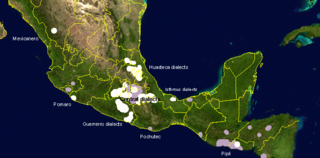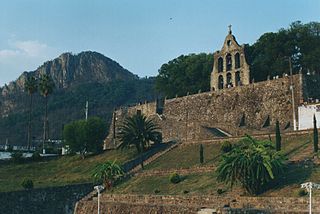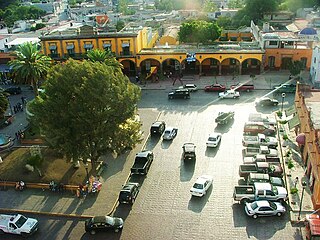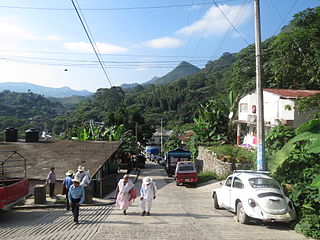
The Totonac are an indigenous people of Mexico who reside in the states of Veracruz, Puebla, and Hidalgo. They are one of the possible builders of the pre-Columbian city of El Tajín, and further maintained quarters in Teotihuacán. Until the mid-19th century they were the world's main producers of vanilla.

The Nahuan or Aztecan languages are those languages of the Uto-Aztecan language family that have undergone a sound change, known as Whorf's law, that changed an original *t to before *a. Subsequently, some Nahuan languages have changed this to or back to, but it can still be seen that the language went through a stage. The best known Nahuan language is Nahuatl. Nahuatl is spoken by about 1.7 million Nahua peoples.

Totonacapan refers to the historical extension where the Totonac people of Mexico dominated, as well as to a region in the modern states of Veracruz and Puebla. The historical territory was much larger than the currently named region, extending from the

The Otomi are an indigenous people of Mexico inhabiting the central Mexican Plateau (Altiplano) region.
The Totonacan languages are a family of closely related languages spoken by approximately 290,000 Totonac and Tepehua people in the states of Veracruz, Puebla, and Hidalgo in Mexico. At the time of the Spanish conquest Totonacan languages were spoken all along the gulf coast of Mexico. During the colonial period, Totonacan languages were occasionally written and at least one grammar was produced. In the 20th century the number of speakers of most varieties have dwindled as indigenous identity increasingly became stigmatized encouraging speakers to adopt Spanish as their main language.

The quechquemitl is a garment which has been worn by certain indigenous ethnicities in Mexico since the pre-Hispanic period. It usually consists of two pieces of rectangular cloth, often woven by hand, which is sewn together to form a poncho or shawl like garment, which is usually worn hanging off the shoulders. It can be constructed of various different fabrics, often with intricate weaves, and is typically highly decorated, most often with embroidery.

La Huasteca is a geographical and cultural region located partially along the Gulf of Mexico and including parts of the states of Tamaulipas, Veracruz, Puebla, Hidalgo, San Luis Potosí, Querétaro and Guanajuato. It is roughly defined as the area in which the Huastec people had influence when their civilization was at its height during the Mesoamerican period. Today, the Huastecs occupy only a fraction of this region with the Nahua people now the most numerous indigenous group. However, those who live in the region share a number of cultural traits such as a style of music and dance, along with religious festivals such as Xantolo.
Tepehua is a language cluster of Mexico, spoken across a number of central Mexican states by the Tepehua people. Tepehua is a Mesoamerican language and shows many of the traits which define the Mesoamerican Linguistic Area. Along with some 62 other indigenous languages, it is recognized by a statutory law of Mexico as an official language in the Mexican Federal District and the other administrative divisions in which it is spoken and it is on an equal footing with Spanish.

The Sierra Norte de Puebla is a rugged mountainous region accounting for the northern third of the state of Puebla, Mexico. It is at the intersection of the Trans-Mexican Volcanic Belt and the Sierra Madre Oriental, between the Mexican Plateau and the Gulf of Mexico coast. From the Mesoamerican period to the 19th century, this area was part of a larger region called Totonacapan, and area dominated by the Totonac people, extending further east to the Gulf of Mexico. Political maneuvers to weaken the Totonacs led to the region being divided between the modern states of Puebla and Veracruz with the Puebla section given its current name. Until the 19th century, the area was almost exclusively indigenous, with the four main groups still found here today, Totonacs, Nahuas, Otomis and Tepehuas, but coffee cultivation brought in mestizos and some European immigrants who took over political and economic power. While highly marginalized socioeconomically, the area has been developed heavily since the mid 20th century, especially with the building of roadways linking it to the Mexico City area and the Gulf coast.

Acaxochitlán is one of the 84 municipalities of the state of Hidalgo, in central-eastern Mexico. The municipality covers an area of 226.1 km². As of 2005, the municipality had a total population of 34,892. Acaxochitlan has three languages; Nahuatl, Spanish, and Otomi.
Huehuetla is one of the 84 municipalities of Hidalgo, in central-eastern Mexico. The municipality covers an area of 262.1 km².

Molango is a town and one of the 84 municipalities of Hidalgo, in central-eastern Mexico. The municipality covers an area of 246.7 km².
San Bartolo Tutotepec is a town and one of the 84 municipalities of Hidalgo, in central-eastern Mexico. The municipality covers an area of 305.8 km².
Tecozautla is a town and one of the 84 municipalities of Hidalgo, in central-eastern Mexico. The municipality covers an area of 575.6 km². The name derives from the Nahuatl words "tetl", meaning "stone"; "cozaqui", meaning "yellow thing"; and "tla", meaning "place of"; making the entire meaning of Tecozautla "place where yellow earth abounds".

Zimapán is a town and one of the 84 municipalities of Hidalgo, in central-eastern Mexico. The municipality covers an area of 860.9 km2 (332.4 sq mi).
The Pantepec River is a river of Mexico that belongs to the Tuxpan River basin, on the Gulf of Mexico slope. The Pantepec River is considered the upper course of the Tuxpan River.
Sierra Otomia.k.a.Highland Otomi is a dialect cluster of the Otomi language spoken in Mexico by ca. 70,000 people in the highlands of Eastern Hidalgo, Western Veracruz and Northern Puebla. The speakers themselves call the language Yųhų or Ñųhų. Lastra 2001 classifies it as an Eastern Otomi language together with Ixtenco Otomi, Tilapa Otomi, and Acazulco Otomi. The three varieties of Sierra Otomi—Eastern Highland, Texcatepec, and Tenango—are above 70% lexically similar; the Eastern Highland dialects are above 80%, and will be considered here.

Pahuatlán, officially Pahuatlán del Valle, is a town and municipality located in the northwest of the state of Puebla in central Mexico. The municipality is part of the Sierra Norte region of the state, a steep mountainous area which receive significant moisture from the Gulf of Mexico, and borders the states of Hidalgo and Veracruz.

Huehuetla is a rural municipality in Puebla, Mexico.

The Totonac culture or Totonec culture was a culture that existed among the indigenous Mesoamerican Totonac people who lived mainly in Veracruz and northern Puebla. Originally, they formed a confederation of cities, but, in later times, it seems that they were organized in three dominions: North, South and Serran. Its economy was agricultural and commercial. They had large urban centers such as: El Tajín (300–1200), which represents the height of the Totonac culture, Papantla (900–1519) and Cempoala (900–1519).













